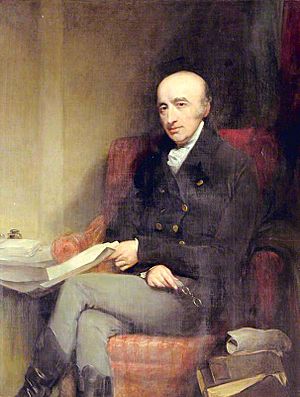William Hyde Wollaston facts for kids
Quick facts for kids
William Hyde Wollaston
|
|
|---|---|
 |
|
| Born | 6 August 1766 East Dereham, Norfolk, England
|
| Died | 22 December 1828 (aged 62) Chislehurst, England
|
| Nationality | British |
| Alma mater | Gonville and Caius College, Cambridge |
| Known for | Discoveries of osmium, palladium and rhodium Camera lucida Conservation of energy Cryophorus Electrochemistry Wollaston prism Wollaston wire Wollaston landscape lens Coining bicarbonate |
| Awards | Copley Medal (1802) Croonian Medal (1809) Royal Medal (1828) Bakerian Medal (1802, 1805, 1818, 1828) |
| Scientific career | |
| Fields | Chemistry Physics |
| 22nd President of the Royal Society | |
| In office 1820–1820 |
|
| Preceded by | Joseph Banks |
| Succeeded by | Humphry Davy |
William Hyde Wollaston was an English scientist. He was a chemist and physicist. He is famous for discovering two chemical elements: palladium and rhodium. He also found a special way to process platinum. This made platinum easier to use.
Contents
A Scientist's Life
William Hyde Wollaston was born on August 6, 1766. His birthplace was East Dereham in Norfolk, England. His father, Francis Wollaston, was an astronomer. William was one of 17 children! His family had enough money. He grew up in a home where learning was important.
He went to Charterhouse School for a few years. Then he studied science at Gonville and Caius College, Cambridge. In 1793, he earned his medical degree (MD). He was also a Fellow at his college.
Wollaston worked as a doctor for a while. He practiced medicine in Huntingdon and Bury St Edmunds. Later, he moved to London in 1797. While studying, he became very interested in chemistry and physics. In 1800, he received a lot of money from his brother. This allowed him to stop being a doctor. He then focused completely on his scientific interests.
He became a member of the Royal Society in 1793. This was a very important science group. He even served as its president for a short time in 1820. He died in London on December 22, 1828. He was buried in Chislehurst, England.
Wollaston's Discoveries and Inventions
Wollaston partnered with another scientist, Smithson Tennant, in 1800. They worked together to make and sell chemical products. Wollaston became very rich from his work with platinum. He found a new way to process platinum ore. This method made platinum useful in large amounts. He kept his process a secret for almost 20 years. This made him the only supplier in England. Platinum was like gold but much cheaper.
His work with platinum led him to discover new elements. He found palladium in 1802. Then, he discovered rhodium in 1804.
Wollaston also did important work with electricity. In 1801, he showed that electricity from rubbing things was the same as electricity from batteries. He did experiments that helped lead to the electric motor. He even invented a special battery. This battery allowed the metal plates to be lifted out of the acid. This stopped the metal from dissolving too quickly.
His work with optics (the study of light) was also very important. In 1802, he noticed dark lines in the light from the sun. This was a big step in understanding how light works. He invented the camera lucida in 1807. This device helped artists draw more accurately. It used a special Wollaston prism. He also made the first lens specifically for cameras in 1812. This lens improved the image quality of early cameras.
Wollaston also created a device called a cryophorus. This glass container could freeze water very quickly using evaporation. He also defended the idea of vis viva. This was an early way of thinking about the conservation of energy. This idea says that energy cannot be created or destroyed.
Wollaston was part of a group that suggested using the imperial gallon as a standard measurement in 1814. He also came up with the name "bicarbonate" in the same year. He helped the government with navigation and opposed using the metric system in 1819.
Awards and Recognition
Wollaston received many honors for his scientific work:
- He became a Fellow of the Royal Society in 1793.
- He was the Secretary from 1804 to 1816.
- He was President for a short time in 1820.
- He was Vice-president from 1820 to 1828.
- He won the Copley Medal in 1802.
- He received the Royal Medal in 1828.
- He gave the Croonian lecture in 1809.
- He gave the Bakerian Lecture four times: in 1802, 1805, 1812, and 1828.
- He became a member of the Royal Swedish Academy of Sciences in 1813.
Wollaston's Legacy
Many things are named after William Hyde Wollaston:
- The Wollaston Medal, an award for geology.
- Wollaston, a crater on the Moon.
- Wollaston Lake in Canada.
- Wollaston Islands in Chile.
- Wollaston Foreland in Greenland.
- Wollaston Peninsula in Canada.
- Wollastonite, a type of mineral.
- Wollaston wire, a very thin platinum wire.
Some people think Wollaston has not received as much fame as he should have. Other scientists from his time, like Thomas Young and Humphry Davy, are much more famous. One reason might be that Wollaston did not always share his discoveries in a clear way. He even published some of his work anonymously at first. Also, his personal notes were missing for over 100 years after he died. They were finally found in the 1960s. This made it hard for people to learn about all his amazing work for a long time.
See also
 In Spanish: William Hyde Wollaston para niños
In Spanish: William Hyde Wollaston para niños
- Fraunhofer lines
- History of electrochemistry
- List of presidents of the Royal Society

